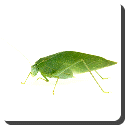 Katydid — The family Tettigoniidae, known in American English as katydids and in British English as bush-crickets, contains more than 6,400 species. It is part of the suborder Ensifera and the only family in the superfamily Tettigonoidea. They are also known as long-horned grasshoppers, although they are more closely related to crickets than to grasshoppers.
Katydid — The family Tettigoniidae, known in American English as katydids and in British English as bush-crickets, contains more than 6,400 species. It is part of the suborder Ensifera and the only family in the superfamily Tettigonoidea. They are also known as long-horned grasshoppers, although they are more closely related to crickets than to grasshoppers.
Tettigoniids may be distinguished from grasshoppers by the length of their antennae, which may exceed their own body length, while in grasshoppers are always relatively short.
katydid common name of certain large, singing, winged insects belonging to the long-horned grasshopper family (Tettigoniidae) in the order Orthoptera. Katydids are green or, occasionally, pink and range in size from 1 1/4 to 5 in. (3-12.5 cm) long. Katydids are nocturnal and arboreal; they sing in the evening. The males have song-producing, or stridulating, organs located on their front wings. The females chirp in response to the shrill song of the males, which supposedly sounds like “katy did, katy didn’t,” hence the name. The song serves a function in courtship, which occurs in late summer. The female lays eggs in the ground or in plant tissue; the eggs hatch in spring. Newly hatched katydids resemble the adults except for their smaller size and lack of wings. Katydids are common in the E United States and are also found in the tropics. They are classified in the phylum Arthropoda , class Insecta, order Orthoptera, family Tettigoniidae.
The spike headed katydid is somewhat notorious for its plantlike appearance, which allows it to blend in with the vegetation on which it lives, and the spikes discourage potential predators.
The males provide a nuptial gift for the females in the form of a spermatophore, a nutritious body produced with the male’s ejaculate.
 Kids Portal For Parents India Kids Network
Kids Portal For Parents India Kids Network
